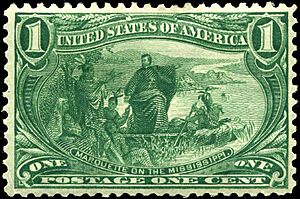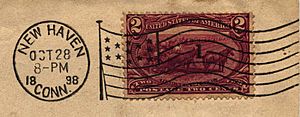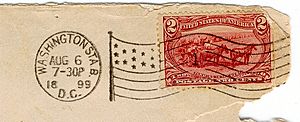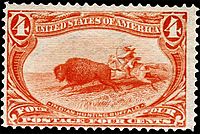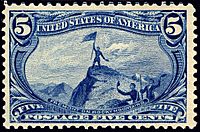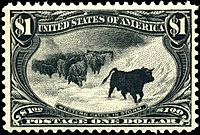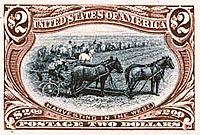Trans-Mississippi Issue facts for kids
The Trans-Mississippi Issue is a special set of nine commemorative postage stamps. The United States released these stamps in 1898. They celebrated the Trans-Mississippi Exposition, a big fair held in Omaha, Nebraska.
These stamps are known for their beautiful engravings. They show different scenes from the American West. Today, stamp collectors really value them. This was only the second time the U.S. Post Office issued special commemorative stamps. The first was the Columbian Exposition series in 1893. Both sets were released for major international fairs. They both offered many different stamp values. Also, both used a wider stamp shape to show detailed pictures.
Contents
How the Stamps Were Created
A key person in making these stamps was Edward Rosewater. He was in charge of publicity for the Exposition. Rosewater was also an expert in stamps. He was a well-known politician. President McKinley chose him to lead the U.S. group at a meeting in 1897. This meeting was for the Universal Postal Union. This group helps make mail flow smoothly between countries.
Rosewater's Idea for Stamps
On December 13, 1897, Rosewater suggested that the Post Office create special stamps. He thought they should celebrate the Trans-Mississippi Exposition. Just like they did for the Columbian Exposition. Ten days later, Postmaster General James A. Gary agreed. He promised a series of five stamps. Their values would range from one cent to one dollar.
Gary asked Rosewater for his ideas on what to show on the stamps. Rosewater sent drawings for five values:
- 1¢: A herd of bison.
- 2¢: An Indigenous person on horseback.
- 5¢: A farmer and his plow horse.
- 10¢: A train going around a steep mountain.
- $1: A goddess holding a torch on a globe.
These stamps would have been large, like the Columbian ones. But they would have been taller than they were wide.
Protests and More Stamps
Gary's announcement made some stamp collectors upset. They were still unhappy about the high price of the 1893 Columbian Issue. That set cost $16.34, which was a lot of money back then. But the Postmaster said he wanted to help people in the West.
Gary later made the set even more expensive. He added four more stamps to the series. This included a $2 stamp. This made the total cost of the set $3.80.
Designing the Stamps
The Bureau of Engraving and Printing wanted these stamps to be very artistic. They wanted them to be as good as, or even better than, the Columbian stamps. They decided to print the Trans-Mississippi stamps with colored frames and black centers. This would have meant printing each stamp twice.
Changes Due to War
However, in April 1898, the Spanish–American War began. The Bureau of Engraving and Printing had to print many revenue stamps for the war effort. To save time and work, they decided to print the Trans-Mississippi designs in single colors.
This change meant they had to rework the designs. The blank spaces around the pictures needed to be filled in. This process delayed the release of the stamps. They came out on June 17, more than two weeks after the Exposition opened.
Despite the collectors' protests, the public liked the stamps. They were sold until the end of the year. Any unsold stamps were sent back and burned. We know how many were printed. But we don't know how many were returned. So, we don't know exactly how many exist today.
The Nine Stamps
Raymond Ostrander Smith designed all the stamps. They all have the same frame shape. "UNITED STATES OF AMERICA" is at the top. The value is shown in numbers at the top. At the bottom, it says "POSTAGE" and the value spelled out for stamps up to 50 cents. The dollar values are just numbers. You can see ears of wheat and corn in the corners of the frame. Each stamp's main picture has a title.
- 1¢ dark green – "Marquette on the Mississippi"
- 2¢ copper red – "Farming in the West"
- 4¢ orange – "Indian Hunting Buffalo"
- 5¢ dark blue – "Fremont on Rocky Mountains"
- 8¢ violet brown – "Troops Guarding Train"
- 10¢ slate – "Hardships of Emigration"
- 50¢ olive – "Western Mining Prospector"
- $1 black – "Western Cattle in Storm"
- $2 orange brown – "Mississippi River Bridge" (the Eads Bridge)
The designs came from different photos, drawings, and paintings. For example, the 8¢ and 50¢ stamps used drawings by Frederic Remington. All the designs are praised for their quality. The $1 stamp, often called the "Black Bull," is especially famous. It's interesting because it doesn't show a scene from the American West. It came from a painting of cattle in Scotland by John MacWhirter.
Engravers
Three engravers worked on the main pictures:
- Marcus Baldwin (for the 2¢, 5¢, 10¢, $1 stamps)
- George Smillie (for the 1¢, 4¢, 50¢, $2 stamps)
- Robert Ponickau (for the 8¢ stamp)
Baldwin also engraved most of the frames. Douglas Ronaldson engraved the frame for the 2¢ stamp. He also engraved all the numbers and letters on the stamps.
A Hidden Detail
The 2¢ stamp has a unique feature. At that time, it was against the rules to show living people on U.S. stamps. But the photograph used for the 2¢ stamp's picture showed three farm workers. These people have been identified as Ed Nybakken, Elihu Barber, and Sam White.
Modern Commemoration
In 1998, the United States Postal Service celebrated the 100th anniversary of these stamps. They released a miniature sheet with all nine designs. Each stamp was printed in two colors. They also released a sheet of nine "Black Bull" stamps.
For most of the stamps, the original colors were kept. But for the "Black Bull," the frame color was changed from violet-brown to bright red. These new designs are reproductions. Each one has a small "1998" in the bottom left corner. In a nod to the original plans, the pictures on the 2¢ and $2 stamps were swapped. Also, "Farming" was changed back to "Harvesting" on the 2¢ stamp.


